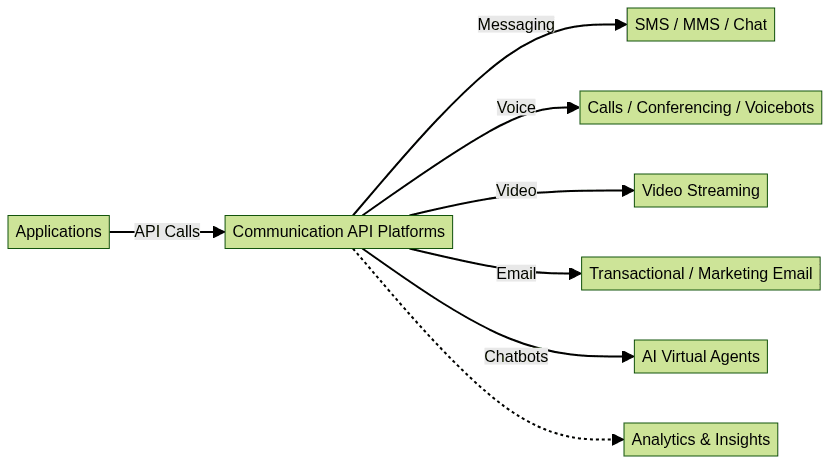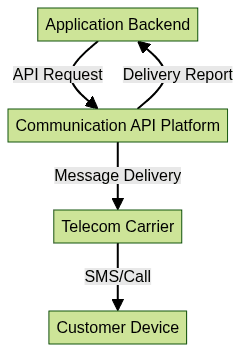Introduction to Communication API Platforms
A communication API platform is a suite of programmable interfaces that enable developers to seamlessly integrate messaging, voice, video, chat, and other communication channels into applications. In today's fast-paced, digital-first world, businesses rely on these platforms to deliver real-time, personalized experiences that drive customer engagement and streamline internal workflows.
Communication API platforms are critical for organizations aiming to meet the rising demand for multichannel and omnichannel customer interactions. Whether it's sending notifications, automating customer support, or facilitating secure transactions, these platforms form the backbone of modern digital communication strategies. Core use cases include SMS alerts, in-app chat, chatbot integrations, voice call automation, and more.
Understanding the Communication API Platform Ecosystem
The communication API platform ecosystem is rich and diverse, featuring industry leaders such as Twilio, Sendbird, PubNub, Plivo, and more. These providers offer APIs covering a broad spectrum:
- Messaging APIs: SMS, MMS, chat, and push notifications
- Voice APIs: Programmable calls, conferencing, IVR, and voicebots
- Video APIs: Real-time
video conferencing and live streaming
- Email APIs: Transactional and marketing email delivery
- Chatbot APIs: AI-powered conversational agents
For developers seeking to add real-time video features, a
Video Calling API
enables seamless integration of high-quality video calls into web and mobile applications, supporting use cases from telehealth to remote collaboration.Over the past decade, these capabilities have converged into CPaaS (Communications Platform as a Service). CPaaS solutions unify disparate communication modalities under a single, programmable cloud platform, empowering developers to build scalable, reliable, and integrated experiences.

Core Features of a Communication API Platform
Messaging APIs (SMS, MMS, chat)
Messaging APIs enable developers to programmatically send and receive SMS, MMS, and chat messages. These APIs are ideal for transactional notifications, two-factor authentication, customer updates, and in-app chat experiences. Robust messaging APIs ensure global reach, message tracking, and high deliverability.
Voice APIs (calls, conferencing, voicebots)
Voice APIs allow applications to make and receive phone calls, set up conference bridges, and power voice-enabled virtual assistants. For developers looking to build audio experiences, a
Voice SDK
provides the tools to implement live audio rooms, group calls, and interactive voice features with minimal effort. They support programmable Interactive Voice Response (IVR) systems and integrate with AI for advanced voicebots, enabling seamless customer support and automated workflows.For businesses that require direct calling capabilities, integrating a
phone call api
can streamline outbound and inbound call flows, automate dialing, and enhance customer engagement.Multichannel and Omnichannel Support
Modern platforms offer multichannel and omnichannel capabilities, allowing developers to engage users across SMS, chat, voice, email, and more from a unified interface. This flexibility enhances customer experience and ensures consistent messaging.
Code Example: Sending a Message via an API (Python)
1import requests
2
3url = "https://api.communicationplatform.com/v1/messages"
4payload = {
5 "to": "+1234567890",
6 "from": "AppName",
7 "body": "Your verification code is 123456."
8}
9headers = {
10 "Authorization": "Bearer YOUR_API_KEY",
11 "Content-Type": "application/json"
12}
13
14response = requests.post(url, json=payload, headers=headers)
15print(response.json())
16Developers working with Python can accelerate integration using a
python video and audio calling sdk
, which simplifies adding real-time communication features to their apps.Benefits of Using a Communication API Platform
Communication API platforms provide a suite of advantages for developers and businesses:
- Scalability and reliability: Cloud-native platforms handle high message volumes and provide SLAs for uptime.
- Cost efficiency: Pay-as-you-go pricing eliminates the need for expensive infrastructure.
- Faster time-to-market: Developer-friendly APIs, SDKs, and documentation accelerate deployment.
- Enhanced customer engagement: Real-time, personalized communications drive loyalty and satisfaction.
If you want to quickly add video features without building from scratch, consider using an
embed video calling sdk
to integrate prebuilt video and audio calling components directly into your application.By leveraging CPaaS, organizations can iterate rapidly while offloading complexity such as carrier relationships, compliance, and scaling.
How to Select the Right Communication API Platform
Key Evaluation Criteria
When evaluating a communication API platform, consider API coverage (messaging, voice, video, chatbots), scalability, developer tools, analytics, and global reach. Assess the quality of documentation, SDKs, and support resources. For web developers, a
javascript video and audio calling sdk
offers a straightforward way to implement real-time communication in browser-based applications.Comparing Leading Platforms
- Twilio: Comprehensive suite, global network, strong developer ecosystem
- Sendbird: In-app chat and community, real-time engagement
- PubNub: Real-time messaging, presence, IoT support
- Plivo: Competitive pricing, voice and SMS focus
Each platform has unique strengths; select based on your application's core communication needs. For cross-platform mobile development, a
flutter video and audio calling api
can help you build robust video and audio features for both iOS and Android.Compliance and Security Considerations
Choose a platform with robust security, GDPR/CCPA compliance, data encryption, and advanced authentication to safeguard customer data and maintain trust.
Practical Implementation: Step-by-Step Guide
1. Setting Up Your Account and Environment
Register with your chosen communication API platform and generate API credentials. Install relevant SDKs and set up environment variables to securely store secrets. If you’re ready to start building, you can
Try it for free
and explore the platform’s capabilities firsthand.2. Authenticating and Securing API Requests
Use secure authentication mechanisms such as API keys, OAuth, or JWT tokens to protect API endpoints. Always use HTTPS for all requests and rotate credentials regularly.
3. Integrating Messaging and Voice APIs
Leverage official SDKs or REST APIs to initiate messaging and voice workflows. The following Python example demonstrates sending an SMS with Twilio:
1from twilio.rest import Client
2
3account_sid = "YOUR_ACCOUNT_SID"
4auth_token = "YOUR_AUTH_TOKEN"
5client = Client(account_sid, auth_token)
6
7message = client.messages.create(
8 body="Hello from your app!",
9 from_="+11234567890",
10 to="+10987654321"
11)
12
13print(message.sid)
144. Monitoring and Handling Responses
Implement robust error handling and logging for API responses to ensure operational reliability. Use webhooks to receive real-time notifications about message delivery or call status.

Advanced Use Cases: AI, Automation, and Analytics
Today's communication API platforms go beyond basic messaging. Developers can leverage AI for chatbot integration and virtual agents to automate customer interactions and resolve queries without human intervention. Automated workflows enable reminders, notifications, and post-interaction surveys, streamlining operations and boosting engagement.
Real-time analytics provide actionable insights by monitoring message delivery, open rates, response times, and customer sentiment. Integration with customer data platforms (CDPs) enables deeper personalization and campaign optimization.
Best Practices for Communication API Platform Integration
- Error handling and rate limiting: Gracefully handle API errors and respect rate limits to avoid service disruption.
- Monitoring and reporting: Use logging, alerting, and dashboards for API usage and system health.
- Ensuring uptime and reliability: Build failover mechanisms and leverage platform SLAs to maintain high availability.
Real-World Success Stories
- eCommerce: A global retailer uses programmable communications to send personalized order updates, automate returns, and provide omnichannel support, resulting in higher NPS scores.
- Fintech: A digital bank leverages SMS and voice APIs for secure transaction alerts, real-time fraud detection, and 24/7 AI-powered customer service.
- Customer Support: A SaaS provider integrates chatbots and multichannel messaging to resolve support tickets faster and reduce operational costs.
Conclusion: The Future of Communication API Platforms
In 2025 and beyond, communication API platforms will continue to evolve with deeper AI integration, hyper-personalized omnichannel engagement, and expansion into emerging markets. By embracing these platforms, developers can deliver secure, scalable, and innovative customer experiences that define the future of business communications.
Want to level-up your learning? Subscribe now
Subscribe to our newsletter for more tech based insights
FAQ